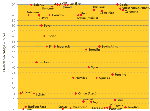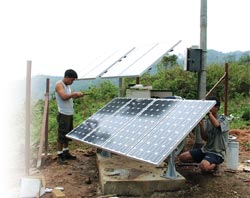|

Yasuhiko Kawasumi (Japan Telecom)
ITU-D Rapporteur on
Communications for rural and remote areas |
Rural communications
on the global agenda
More than 2.5 billion people (about 40 per cent of the world’s
population) live in the rural and remote areas of developing countries where
access to telecommunications is still very limited, according to an ITU
worldwide survey on rural communications. The issue of communications for rural
and remote areas is critical to the ITU membership. From the Valletta Action
Plan (1998) to the Istanbul Action Plan (2002) — and more recently the Plan of
Action of the World Summit on the Information Society (WSIS) held in Geneva in
December 2003 — policy statements and recommendations have confirmed the need to
promote basic telecommunication, broadcasting and the Internet as tools for
development in rural and remote areas.
Eliminating disparities in access to, and use of, information and communication
technologies (ICT) is now firmly on the global agenda. Of the ten targets
embedded in the WSIS Plan of Action, “Target 1” specifically underlines
“Connecting villages with ICTs and establishing community access points”. In
this regard, the report of the survey, conducted by an ITU Rapporteur’s Group
studying the question of “Communications for rural and remote areas”, could not
have been more timely. Released in June 2004, the survey analysis indicates that
many of the problems facing rural areas are outside the scope of
telecommunications alone to resolve and require coordination of rural
electrification, transport network development, education and training
programmes.
| *The term respondent is used in this article to indicate the
information provided by a responding economy, rather than the individual
responding organization. |
Figure 1 — Largest age group in rural areas
 |
Besides, there is a need to design more cost-effective technology
solutions for
rural areas with the needs and economies of
rural communities in mind. The extensive data collected from 52* economies
across the regions of the world should help the ITU membership examine the means
to address the critical challenge of providing connectivity to rural and
remote communities. This article highlights some of the findings from the
survey.
Percentage of women living
in rural areas
There are over 268 million people living in the rural areas of the 52 economies
that responded to the questionnaire. As Figure 1 illustrates, the largest age
group found within rural areas of these economies is that of young people under
the age of 16. The average percentage of women living in the rural areas is 53.
However, within some countries, there is significant variation from this median
with Uganda, Lesotho and South Africa estimating the percentage of women living
in rural areas to exceed 80 per cent of their rural populations.
Income disparity between rural
and urban areas
Figure 2 — Comparing income between rural and
urban populations
 |
The survey revealed a huge income disparity between rural areas and estimated
national income per capita. This disparity presents major problems for operators
attempting to deliver services spanning such economic divides. Figure 2 shows
data for all the economies that provided information for both urban and rural
incomes, except for Cyprus and Japan whose incomes were too large to be
represented on the graph. Cyprus reported a rural income of USD 12 000 and a
national (urban) income of USD 17 000. In the case of Japan, the rural income
was reported at USD 30 000, with national (urban) income at USD 37 500.
|
Figure 3 —
Services in rural areas
 |
Figure 4 — Cost of services |
What services are available
in rural areas?
Of the small fraction of people in rural areas that have access to
telecommunications, radio broadcasting and fixed-voice telephony have
traditionally been the main services provided. In recent times, mobile telephony
has been critical for enhancing this access, in some economies surpassing fixed
lines. Internet-based services are yet to have any significant impact on most
rural areas. Figure 3 provides an overview of the services available in the
rural areas of respondent economies.

E-business and e-commerce could play an
important role in enabling local artisans to reach national and
international markets
ITU 040039/C. Cox |
The difference in cost of services between rural and urban areas
Some 69 per cent of respondents stated that prices in rural areas were the same
as those in urban areas, while 21 per cent indicated that services were more
expensive in rural areas (Figure 4). Even when pricing is the same in both urban
and rural areas, income disparities between rural and urban communities make
communication services more expensive for
rural dwellers. Egypt is the only country to
have reported cheaper pricing structures for rural areas.
Access to basic telephony
Some 79 per cent of the surveyed economies responded to the question of access
to basic telephony in rural areas. Oman provided data on overall access for both
its fixed and mobile networks. The fixed network provides access to 15 per cent
of rural Oman, with the mobile network providing 90 per cent of the access. A
number of countries including Benin, Burkina Faso, Ecuador, Honduras, Kenya,
Lesotho, Mauritania, Paraguay, Peru, Senegal and Togo have situations where less
than 10 per cent of their rural areas have access to basic telephony. Figure 5
shows the range of access in the different economies.
Gender and equal access
to basic telephony
Of the 18 economies that answered the question on the percentage of females who
have
access to basic telephony, some pointed to a
continuing and clear bias to male access to telecommunications over female
access. Figure 6
illustrates disparities in access where they exist.
| Figure 5 — Porcentage of rural areas with
access to basic telephony by economy
 |
Policies and strategies to encourage rural access to telecommunications
Around 47 per cent of respondents had universal service obligations in place. A
further 28 per cent had legislation, dedicated government agencies or objectives
for encouraging rural access but did not specifically mention universal service
obligation as a method of
encouragement (Figure 7).
Many respondents (53 per cent) indicated that Internet/broadcasting is included
in their rural access strategies (Figure 8). Of the 29 economies which answered
the question on “Universal Service Fund”, 12 stated that such a fund had been
established as part of the universal service or access legislation and a further
four countries (Albania, Côte d’Ivoire, Grenada and Kenya) indicated that
universal service funds were either in the process of being planned or
implemented but not yet fully functional.
Literacy in rural areas
The number of children completing primary school education and illiteracy rates
in the respondent economies varied hugely. Figure 9 summarizes data
received on the literate population in the rural areas surveyed.
Rural populations and their ICT needs
Figure 10 summarizes the needs of rural
people in connection with e-services based on data from 25 economies. E-health,
e-education and e-administration top the list as primary needs. ICT training and
the need to create awareness amongst rural people of the relevance of
e-services were underlined. E-business and
e-banking also scored highly, with a number of respondents commenting on how
e-business and e-commerce could play an important role in
enabling local artisans and farmers to reach
national and international markets. Other needs include general ICT access,
unrestricted or uncensored Internet access, as well as access to specific
Internet services such as e-mail and Web publishing.
| Figure 7 — Policies and strategies to
encourage rural access
 |
Figure 8 — Internet and/or broadcasting
in rural access strategies
 |
|
Figure 9 —
Porcentage of literacy in rural areas

|
Main barriers to e-services
Rural areas encompass a range of geographical terrain including forest, desert,
grasslands, mountain regions and isolated islands. This constitutes a primary
challenge for many rural areas, as difficult terrain, compounded with poor
levels of transport infrastructure increase the cost of establishing, operating
and maintaining telecommunication infrastructure. Delivering
affordable and accessible services to populations with very low disposable
incomes and general lack of capital to acquire telecommuncation equipment is
another challenge. Furthermore, for many rural areas, ancillary services such as
electricity supply are simply non-existent or insufficient. In some developing
countries, the
deployment of wireless local loop technologies is emerging as a way to overcome
such barriers.
|
Figure 10 —
Needs of rural populations in relation
to e-services
 |
High degrees of illiteracy in some rural areas, as well as cultural issues based
upon oral traditions rather than written ones are sociological barriers to the
adoption of e-services.
In economies where Internet services were reported to be poor or non-existent,
suggestions on how to improve this situation were primarily related to
infrastructure investment and
capacity building. The majority of responses underlined the need to modernize
existing infrastructure by replacing analogue systems with digital ones or by
purchasing other modern communication technologies that are more suited to rural
deployment.
Finally, there is a perceived lack of local content and services relevant to
daily rural life, as well as a lack of experience and tools to produce this
content in local languages. In general, the Internet is still very much
perceived as being oriented towards developed urban environments.

A telemedicine project interconnecting
hospitals in Thimphu and Trashiyangtse (Bhutan) via telephone lines
ITU 040038/Toka University |

For many rural areas, electricity supply is simply non-existent or insufficient
ITU 040041/C. Cox |
|
About the survey
The survey was conducted between November 2002 and mid-April 2003 and an
analysis report has been compiled that will be presented to the September
meeting of Study Group 2 of the ITU Telecommunication Development Sector (ITU-D)
for further action. This survey was based on a questionnaire developed by the
Telecommunication Development Bureau (BDT), in consultation with the
Rapporteur’s Group on “Communications for rural and remote areas”, which works
under the umbrella of ITU–D Study Group 2. The questionnaire was sent to all ITU
Member States and Sector Members to gather data on the status of
telecommunications in rural and remote areas. By mid-April 2003, some 55
responses had been received describing the situation in 52 economies (51 Member
States and the Palestinian Authority, which has observer status at the ITU).
Chad, which responded after the closing date of the survey brings that number to
53. Data from Chad are not included in this article, but will be incorporated in
the final version of the survey analysis report to be made available later in
the year. |
|


